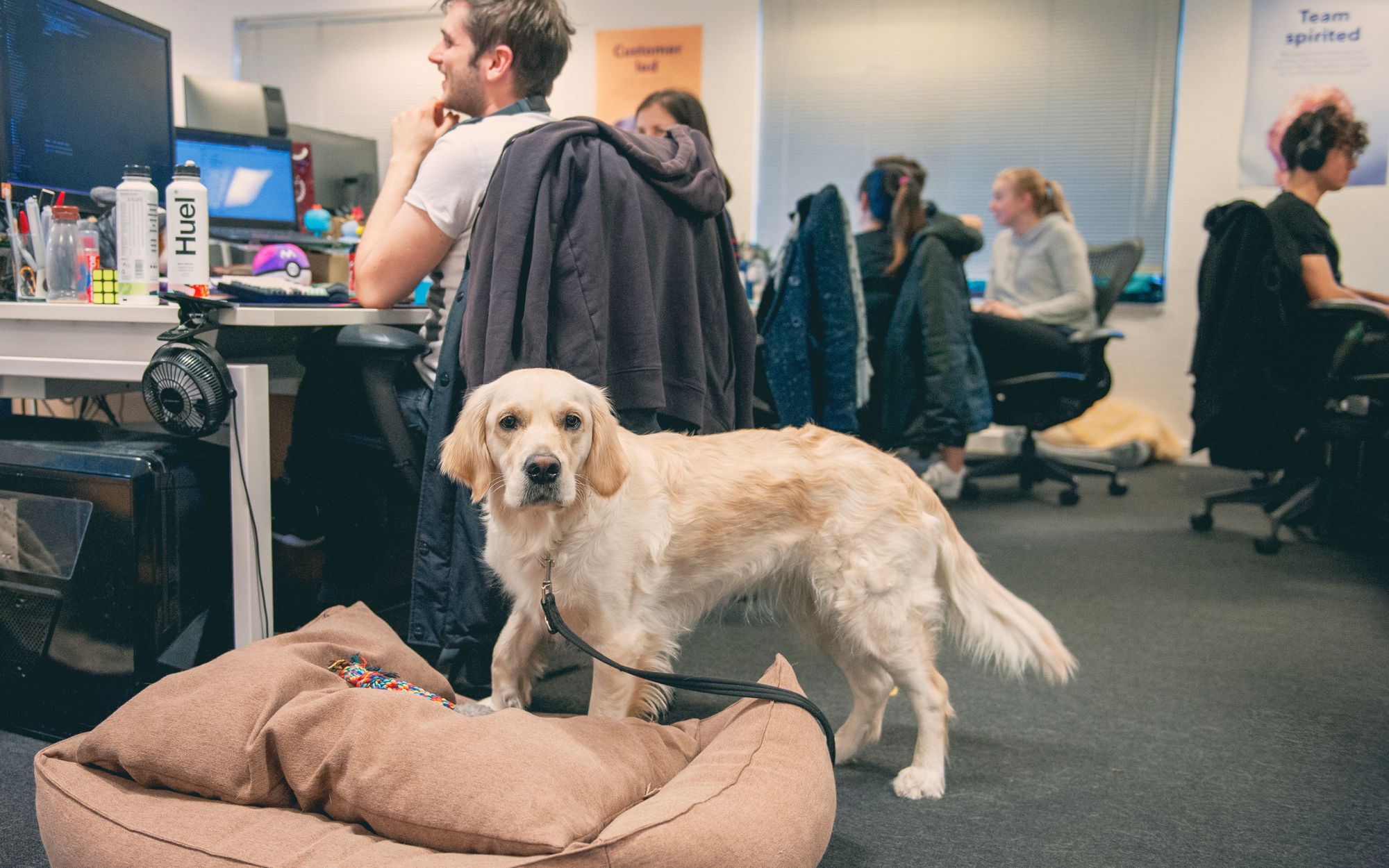The scores are in and, nearly 90% of our LinkedIn followers say they would love to work in a dog-friendly office.
But how do you go about making that work?
If, like us, you’re lucky enough to already have a dog-friendly environment, or you’re considering how to turn your office into one, here are a few tips from our Head Vet, Sean McCormack, on how to make the introduction to the office as fun and stress-free as possible.
Tips to get you and your pup ready for the 9-5
1. Home Comforts
It’s important that your dog feels at home in the office environment so gathering a few of your dog’s favourite items will help them to acclimatise. Bring their bed in so they can zonk out while you work, pack some of their favourite toys to remind them of home and bring lots of treats to reward them for good behaviour.
2. Train Your Dog to Behave at Work
If your dog is returning to the office after a long break, or it’s their first time at the office, they will most likely want to bark, run and jump as they’ll be excited to explore their new surroundings. But, you can easily nip these in the bud with some simple training - teaching them to sit and stay, for example, will help you to keep them calm by giving them commands.
Barking can be difficult to discourage but a good way of reducing it can be to ignore it as much as possible. When it comes to dissuading unwanted behaviours like barking, remember that the goal is to reward the good behaviour, not punish the bad. Encourage your dog when they’re behaving the way you like, and ignore them when they’re acting less than professional!
3. Socialise Your Dog for Work
Remember how nervous you were on your first day of work? Well, your dog will feel exactly the same way on their return to work or first time at the office.
Here are a few steps you can take to get your dog ready to handle the office.
- Introduce Your Dog to Coworkers: Take your dog for a quick, leashed walk around the office and introduce them to the people in your area. Offer treats and praise when your dog is behaving well when they meet new people
- Introduce Your Dog to Coworkers’ Dogs: Go for a walk in neutral territory with other dogs from the office and their owners. Give plenty of treats for both dogs as you make the introduction. Watch out for signs of stress or aggression. If things are going well, just back off for a while.
- Get Your Dog Ready for the Commute: If your dog’s only experience with the car is to either the vet or the groomer, they'll enjoy the commute to and from work even less than you do. Take them for a few fun trips in the car so they don’t always associate travel with fear or anxiety.
4. Toilet Training Your Dog for Work
If your dog is returning to the office with you after the lockdown they should have the potty training nailed at work, but accidents can happen. When you are back in the office continue with these best practices:
- Take lots of outdoor bathroom breaks and walks
- Reward your dog when they go outside, where they’re supposed to
- Do not punish them if there’s an accident, as this can make matters worse
- Don’t forget to pack poop bags as well as cleaning supplies… just in case
5. How to Tell If Your Dog Is Stressed at Work
Going back to the office or indeed going to the office for the first time could be scary for your pooch and stress them out. Some of the signs to look out for are:
- Ears Pulled Back: If your dog’s ears are pulled back tightly against their head, mixed with a tense body posture, they are likely nervous and should not be forced into more intense situations.
- Lip Licking: Is your dog licking their lips/nose like they just gobbled down a meal, even when they haven’t had anything to eat or drink? If so, this is often a sign of stress. Ease up and give them a safe space.
- Scratching: If your dog suddenly starts scratching but you have no reason to believe they’re itchy, it could be another sign they’re stressed.
- Shaking: Full-body shaking — like after your dog comes out of a bath — is one way your dog might try to release stress by literally trying to shake it off.
- Tucked Tail: An elevated and wagging tails means all signs are good but a tail tucked firmly between their legs means you’ve got a frightened pooch on your hands. However, be mindful of other signs your dog is displaying, as tail wagging can just as easily be a sign that they’re angry/agitated as happy/excited.
- Whale Eyes: A wary dog will often give you “whale eyes.” This is where their head is pointed one way, while they give someone a sidelong glance. This often means they are keeping an eye on a potential threat, while keeping their body aimed in the direction they’ll go if/when it’s time to skedaddle.
- Barking, Growling, Cowering: While you might recognize the symptoms of a dog that doesn’t want to interact, others might not. Kindly let your coworkers know that a barking or growling dog wants to be left alone and will not be won over.
If you see your dog exhibiting any of these stressful behaviours, give them a break from the office by either taking them home, letting them hide out in their crate or bed to calm down, or no longer bringing them to work while you continue socialisation and training in a more controlled environment.


